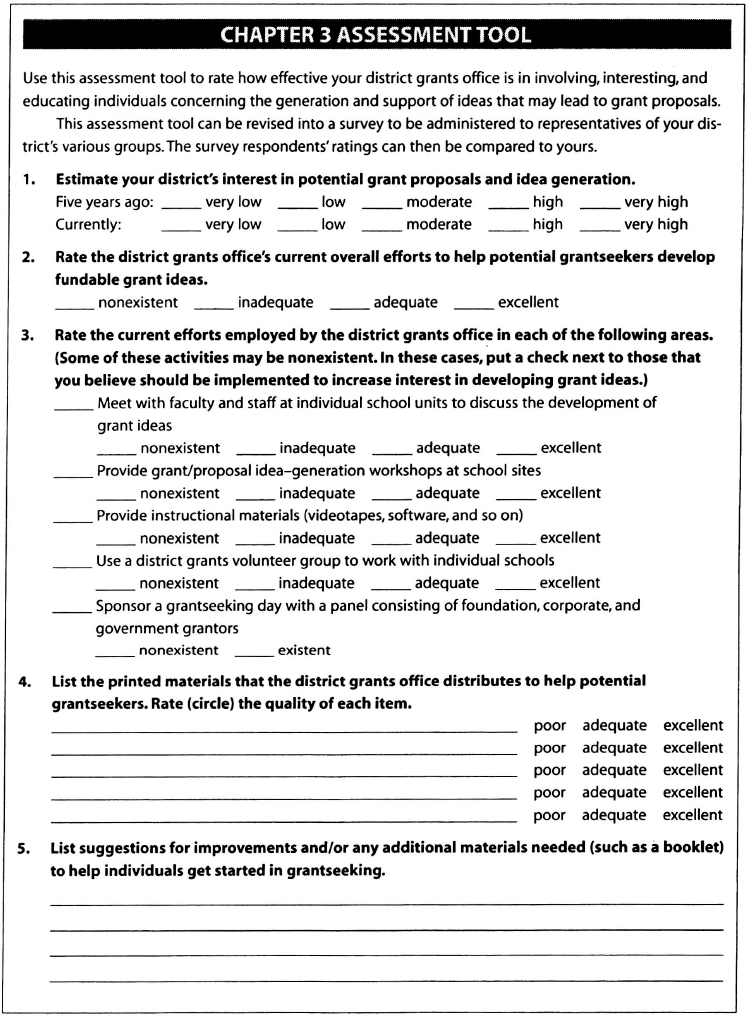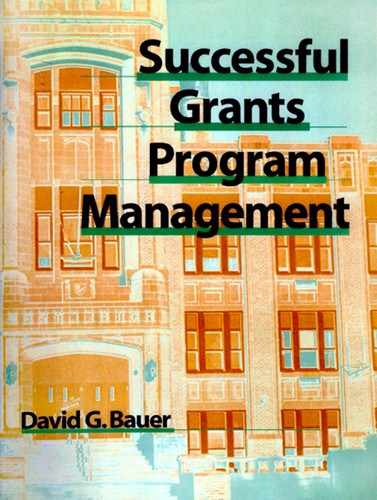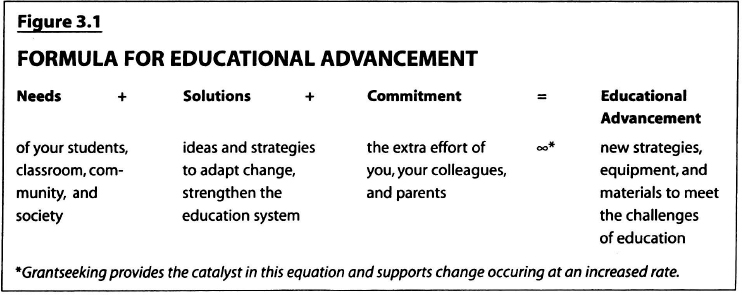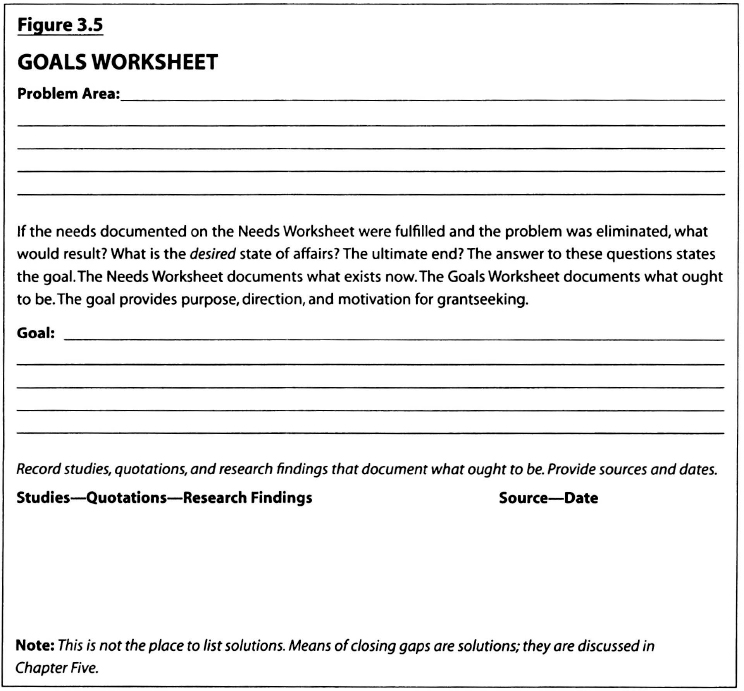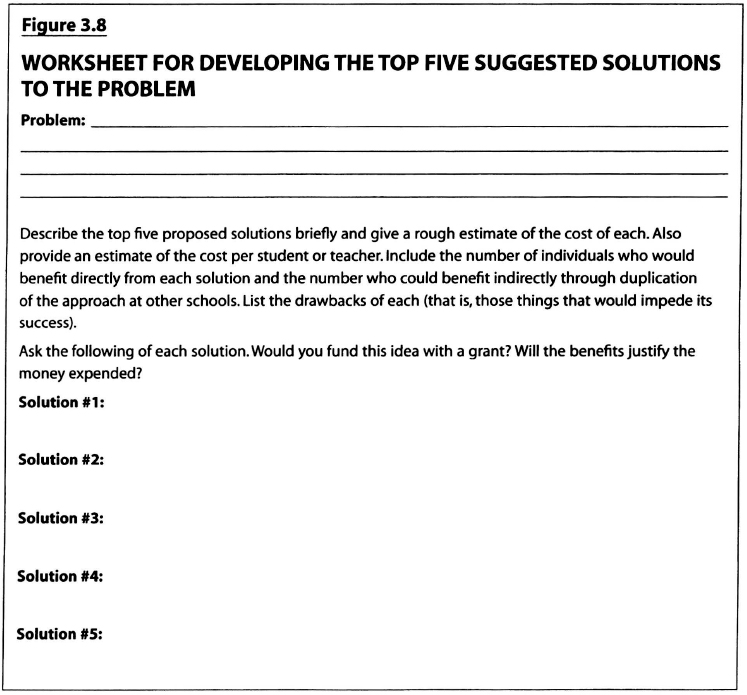Chapter 3
Developing Your School's Ability to Create Grant-Winning Solutions
HELP YOUR SCHOOLS articulate their priorities, demonstrate to them how the grants mechanism can meet their needs, and motivate them to further involve themselves in generating proposals.
How? Depending on your schedule and the role you seek to play, you may want to do the following:
- Visit each school to explain how the district grants office can help.
- Conduct in-service classes on documenting need and proposal development.
- Distribute booklets on how to get started in grantseeking at faculty meetings, fall orientation, and new-teacher orientation.
Grant Idea Generation System
Quality ideas developed through the input and sharing of the entire school/community are what an outstanding proposal is all about. It is crucial that the district grants office implement an idea generation system aimed at bringing volunteers and school representatives together to develop ideas to address their prioritized needs. But before they jump in, you must help them do the following:
- Understand the formula for educational advancement
- Focus on the needs gap
- Document the need or problem area
- Identify the desired outcome or goal
The Formula for Educational Advancement
This formula is a visual aid you can use with grantseekers to illustrate the ingredients necessary to develop strategies to meet the challenges of education (see Figure 3.1).
The main ingredients of the formula are needs, solutions, commitment, and catalyst. Each is equally important in moving toward the goal of educational advancement.
First, needs must be identified. Needs are commonly thought of as problems, but they are actually opportunities to create change. For example, low reading scores provide the opportunity to increase reading levels, and the expansion of an existing successful program provides the opportunity to build on proven achievement.
Second, solutions should be generated in response to the district's predetermined needs—not because a grantor has dedicated funding to a specific area.
Third, the commitment and extra effort of educators and community leaders are essential to convince grantors that there is a genuine concern for addressing the need. Most grassroots grantseeking is accomplished as a result of this donated effort.
The catalyst in the formula is grant money. In this formula the catalyst speeds up the grant reaction. Your schools will move toward their goals irrespective of the availability of grants; but grants will allow them to get there faster.
This formula helps demonstrate to potential grantors that the desired educational advancement is worth their money.
As districts seek to accomplish their mission through increased grants, the central grants office must be sure that all of the components of the formula for educational advancement are present and balanced. A district's long-term credibility and ability to attract grants can be negated by submitting proposals with excellent solutions but no documented needs, or with documented needs and exemplary solutions but no school/community commitment or involvement.
Helping Your Grantseekers Focus on the Needs Gap
This is one of the most critical areas in grantseeking. Unfortunately it also often gets overlooked and minimized in proposal preparation. To focus your grantseekers on a prioritized system, you must help them separate what they want to do from why it needs to be done. For example, the need to upgrade a computer lab or computer classroom capabilities is not documented by providing an inventory of old equipment and a list of the latest computers and software. Grantors may or may not know how beneficial new technology is for the classroom, or whether the potential grantee has a solution that will help with the problem. Even if the grantor knows a lot about the problem, the grantseeker must demonstrate in-depth knowledge of it.
One of the most difficult tasks in grantseeking is to help the proposal developers focus on the problem instead of the solution. If they do, they will clearly see the gap between what is and what ought to be and realize that their proposed solution is just one of many ways to gain the desired outcome.
You can help your grantseekers focus on need by asking them why anyone would care about closing the gap between what is and what ought to be (see Figure 3.2) and by encouraging them to consider what, if anything, would happen if the problem was never addressed.
Documenting the Need
Ask your prospective grantseekers to complete a Needs Worksheet (Figure 3.3) to guide them in collecting the data necessary to convince a grantor that they have the following:
- A command of the most recent literature and of worldwide, national, and regional studies of the problem
- Knowledge of the extent of the local problem (studies, surveys, statistics, and other data that document its existence)
Give your grantseekers a list of the district offices that accumulate data that may help them document the existence of the local problem. This will discourage the collection of unreliable or conflicting data concerning your district and the students and communities you serve. Pertinent district information may include the following:
- Geographical and demographic data
- Achievement scores for reading, math, and science
- Attendance data
- Completion and dropout rates
- Health data
- Job placement statistics
- Financial information
Encourage your grantseekers to compare your district's needs data with studies and articles related to the problem areas they seek to have an impact on. Your state education department and schools of education are constantly producing studies and comparisons your grantseekers should have. By placing your schools' data on a website your grantseekers have access to, or on a disk that is circulated to them, you help ensure that false or conflicting data does not appear in the needs section of any proposals put out by your district. The gap that your grantseekers must document between what is and what ought to or could be must demonstrate a clear, compelling, and motivating case for funding their proposal.
The needs statements in your district's proposals will gain credibility when they compare local statistics with regional, national, or international data. Your grantseekers' knowledge of your district's needs data and their command of the national data will add to your district's credibility and hence fundability. The needs section of a proposal may actually be considered more important to reviewers and represent a greater percentage of points when scoring than the objectives and methods section. This is due to the strong relationship needs documentation has to the construction of measurable behavioral objectives and the demonstration of the proposed project's ability to close the gap between what exists and what ought to or could be. The secret is to provide needs documentation that clearly demonstrates what exists in your school and also how your school's problem relates to the problem on a national level or to a particular type of school (such as rural or urban).
When you uncover a particularly interesting study that shows a national need, you could repeat the study in your school to determine if its need is the same, greater, or less. Figure 3.4 is a sample of a needs worksheet based on a national study conducted several years ago surveying twenty-five thousand middle school children. The results of the survey were striking. Your grantseekers could get a small corporate or local foundation grant to see how these findings have changed over time, and particularly since the introduction of the Internet, video games, and other computer-related recreational diversions. In other words, has the level of parental involvement and the constructive use of informal educational experiences changed, and if so, how? A reviewer and ultimately a grantor would be impressed with your up-to-date data and your ability to document the changes called for in your proposal's objectives.
Identifying the Desired Outcome or Goal
A gap requires that there be two end points. With some encouragement and examples, most grantseekers do a good job at documenting the first end point, or what exists now (the left side of Figure 3.2), but have a harder time trying to document what could be or should be (the right side of Figure 3.2).
The Goals Worksheet (Figure 3.5) will help your grantseekers focus on what the desired outcome would be if we lived in a perfect world and if money and time were not constraints. Although goals are often not achieved, they do help grantors see where projects are headed and understand the gap between what exists and the desired state of affairs. You can also suggest that your grantseekers survey local officials, experts, teachers, or parents to determine what they think ought to be or should be relative to the problem and demonstrated gap.
In the sample worksheet (Figure 3.6), the goal is to have all parents and teachers act as responsible partners who work together to maximize the educational achievement of children. Because there will always be a few parents and teachers who will not act responsibly, the goal is not likely to be attained; however, it is hoped that the proposed solution will reduce the gap and move the school/community closer to the goal.
Developing Fundable Solutions
One role of your district grants office is to provide services to help potential grantseekers develop solutions to the problem areas they have identified. This assistance is a great step toward encouraging high-quality, well-developed proposals. Encourage your grantseekers to brainstorm proposal ideas (solutions) with volunteers, fellow staff members, and professionals in the school/community. Involving others provides a means to do the following:
- Move from a single or self-focused approach
- Incorporate the best components of several approaches into one idea
- Involve others in the project at an early stage of its development, thus increasing commitment and the potential for a consortia proposal
Ask your grantseekers to complete the Worksheet for Developing Solutions and Projects to Reduce the Problem (Figure 3.7). They should record and rank all the proposed solutions. The group leader should tabulate the results and identify the five highest-ranked ideas.
The five should then be placed on the Worksheet for Developing the Top Five Suggested Solutions to the Problem (Figure 3.8). Actually, fewer than five solutions may be listed as long as the grantseekers generate more than one solution, maintain a broad view of the problem, and remain flexible when analyzing each solution. Grantseekers should be reminded that being able to locate grantors willing to fund their proposal is in part a function of their flexibility and ingenuity.
The idea generators should use the spaces provided on the worksheet to describe each solution, estimate the cost of each approach and the cost per person served, and list the drawbacks associated with each idea. Note that the worksheet has a place to record whether the problem addressed by the proposed solutions is a district priority. This is the district office's first indication of grants interest and will help the office forecast its potential workload.
In the sample worksheet provided (Figure 3.9), the grantseekers may decide that combining solutions one and two will result in a greater likelihood that the proposed change will occur.
Your district may decide to develop a booklet comprising selected worksheets to help your individual school units get started in grantseeking. The worksheets listed in the Sample Booklet (Figure 3.10) should be tailored to each school unit. Your booklet may include a short narrative describing how to use each of the worksheets.
